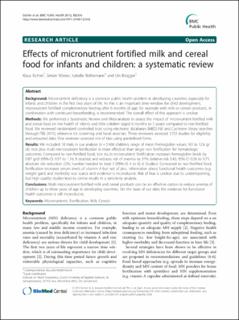Please use this identifier to cite or link to this item:
https://doi.org/10.21256/zhaw-4050| Publication type: | Article in scientific journal |
| Type of review: | Peer review (publication) |
| Title: | Effects of micronutrient fortified milk and cereal food for infants and children : a systematic review |
| Authors: | Eichler, Klaus Wieser, Simon Rüthemann, Isabelle Brügger, Urs |
| DOI: | 10.21256/zhaw-4050 10.1186/1471-2458-12-506 |
| Published in: | BMC Public Health |
| Volume(Issue): | 12 |
| Issue: | 1 |
| Page(s): | 506 |
| Pages to: | 519 |
| Issue Date: | 2012 |
| Publisher / Ed. Institution: | BioMed Central |
| ISSN: | 1471-2458 1471-2458 |
| Language: | English |
| Subjects: | Fortification; Cereals; Micronutrients; Milk |
| Subject (DDC): | 613.2: Dietetics |
| Abstract: | Background: Micronutrient deficiency is a common public health problem in developing countries, especially for infants and children in the first two years of life. As this is an important time window for child development, micronutrient fortified complementary feeding after 6 months of age, for example with milk or cereals products, in combination with continued breastfeeding, is recommended. The overall effect of this approach is unclear. Methods: We performed a Systematic Review and Meta-analysis to assess the impact of micronutrient fortified milk and cereal food on the health of infants and little children (aged 6 months to 5 years) compared to non-fortified food. We reviewed randomized controlled trials using electronic databases (MEDLINE and Cochrane library searches through FEB 2011), reference list screening and hand searches. Three reviewers assessed 1153 studies for eligibility and extracted data. One reviewer assessed risk of bias using predefined forms. Results: We included 18 trials in our analysis (n = 5’468 children; range of mean hemoglobin values: 9.0 to 12.6 g/dl). Iron plus multi micronutrient fortification is more effective than single iron fortification for hematologic outcomes. Compared to non-fortified food, iron multi micronutrient fortification increases hemoglobin levels by 0.87 g/dl (95%-CI: 0.57 to 1.16; 8 studies) and reduces risk of anemia by 57% (relative risk 0.43; 95%-CI 0.26 to 0.71; absolute risk reduction 22%; number needed to treat 5 [95%-CI: 4 to 6]; 6 Studies). Compared to non-fortified food, fortification increases serum levels of vitamin A but not of zinc. Information about functional health outcomes (e.g. weight gain) and morbidity was scarce and evidence is inconclusive. Risk of bias is unclear due to underreporting, but high quality studies lead to similar results in a sensitivity analysis. Conclusions: Multi micronutrient fortified milk and cereal products can be an effective option to reduce anemia of children up to three years of age in developing countries. On the basis of our data the evidence for functional health outcomes is still inconclusive. |
| URI: | https://digitalcollection.zhaw.ch/handle/11475/12823 |
| Fulltext version: | Published version |
| License (according to publishing contract): | CC BY 2.0: Attribution 2.0 Generic |
| Departement: | School of Management and Law |
| Organisational Unit: | Winterthur Institute of Health Economics (WIG) |
| Published as part of the ZHAW project: | Burden of micronutrient deficiencies and cost-effectiveness of interventions with fortified foods |
| Appears in collections: | Publikationen School of Management and Law |
Files in This Item:
| File | Description | Size | Format | |
|---|---|---|---|---|
| Eichler2012_Article_EffectsOfMicronutrientFortifie.pdf | Effects of micronutrient fortified milk and cereal food for infants and children : a systematic review | 348.55 kB | Adobe PDF |  View/Open |
Show full item record
Eichler, K., Wieser, S., Rüthemann, I., & Brügger, U. (2012). Effects of micronutrient fortified milk and cereal food for infants and children : a systematic review. BMC Public Health, 12(1), 506–519. https://doi.org/10.21256/zhaw-4050
Eichler, K. et al. (2012) ‘Effects of micronutrient fortified milk and cereal food for infants and children : a systematic review’, BMC Public Health, 12(1), pp. 506–519. Available at: https://doi.org/10.21256/zhaw-4050.
K. Eichler, S. Wieser, I. Rüthemann, and U. Brügger, “Effects of micronutrient fortified milk and cereal food for infants and children : a systematic review,” BMC Public Health, vol. 12, no. 1, pp. 506–519, 2012, doi: 10.21256/zhaw-4050.
EICHLER, Klaus, Simon WIESER, Isabelle RÜTHEMANN und Urs BRÜGGER, 2012. Effects of micronutrient fortified milk and cereal food for infants and children : a systematic review. BMC Public Health. 2012. Bd. 12, Nr. 1, S. 506–519. DOI 10.21256/zhaw-4050
Eichler, Klaus, Simon Wieser, Isabelle Rüthemann, and Urs Brügger. 2012. “Effects of Micronutrient Fortified Milk and Cereal Food for Infants and Children : A Systematic Review.” BMC Public Health 12 (1): 506–19. https://doi.org/10.21256/zhaw-4050.
Eichler, Klaus, et al. “Effects of Micronutrient Fortified Milk and Cereal Food for Infants and Children : A Systematic Review.” BMC Public Health, vol. 12, no. 1, 2012, pp. 506–19, https://doi.org/10.21256/zhaw-4050.
Items in DSpace are protected by copyright, with all rights reserved, unless otherwise indicated.